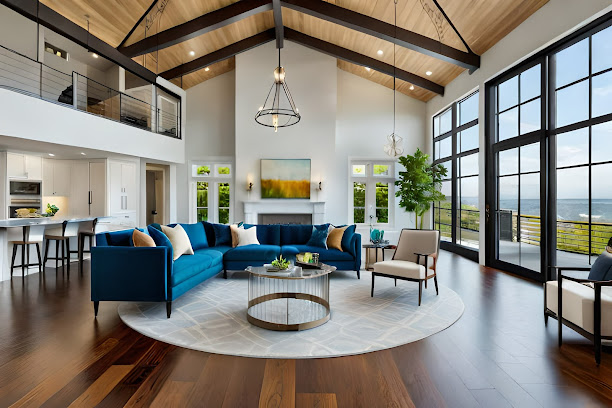Vaulted ceilings aren’t just for church anymore. These highfalutin room lids can be an impressive statement that can add space and natural light and transform a plain-Jane living room into your own shrine to good taste in home design.
What is a vaulted ceiling?
Over the years, the phrase “vaulted ceiling” has grown to encompass much more than it originally did, to the point that many people think of high ceilings and vaulted ceilings interchangeably. “Historically, vaulted ceilings referred to any arched ceiling below a roof and above walls, like a dome or a barrel vault,” says Connecticut-based architect Ming Thompson, principal of Atelier Cho Thompson. “Today, though, it means any type of interior ceiling that takes advantage of the space between the roof and what would be a flat ceiling.” If you’re curious to see different way designers have put this feature to use, consider these vaulted ceiling ideas.
What types of vaulted ceiling are there?
Cathedral ceilings, the kind most homeowners think about when they hear the words “vaulted ceiling,” are just a type of vaulted ceiling. Cathedral ceilings have flat, diagonal planes rising from the tops of the walls to a central high point and (usually) following the roof structure.
Other types of vaulted ceilings common in architectural design include barrel-vaulted ceilings (which are exactly what they sound like—like you’re inside a giant barrel on its side), groin vaults (two or more barrel-vaulted ceilings crashing into each other at right angles), rib vaults (like a groin vault but meeting at ribs on top), and dome ceilings. Barrel vaults are also known as tunnel vaults or wagon vaults. (A cupola is not a vaulted ceiling. It’s a separate structure like a small dome or turret that sits on top of a roof.)
The mainstream definition’s gotten loose enough to sometimes include sloped ceilings (also known as shed ceilings) as a type of vaulted ceiling—these have one high edge and one ledge and don’t have to be tied to the building structure.
What are the advantages of having a vaulted ceiling?
If you want a room itself to be a statement piece, a vaulted ceiling will definitely fit the bill, if executed correctly. It can create a new spatial geometry that changes the scale of the room feel and adds grandeur with a capital G.
“If you have standard ceilings everywhere else, a vaulted ceiling’s a way to create this 'Wow!' moment,” San Francisco–based architect Monica Sanga says. “Walking from a uniform space to a vaulted ceiling gives you a narrative as you walk into a room.”
You also get more vertical space with vaulted ceilings, which means that you have more opportunities to let in natural light (or artificial light, like with chandeliers or other otherwise impractical light fixtures) and showcase your home’s surroundings.
“The increased wall area gives you more space for windows and therefore more light and potential views,” Rachel Bullock, cofounder and studio director of AD PRO Directory firm Laun Studio, in Los Angeles, says.
And even if your views are of the town tire fire, you can still use a vaulted ceiling to elevate the atmosphere of your home. “Vaulted ceilings provide generous space overhead,” Thompson says. “While they don’t add floor area, they do give a sense of airy grandeur, and can help cramped rooms feel more special and large. Vaulted ceilings also eliminate space that might be otherwise captured in an attic, which means you can more easily add useful skylights in the ceiling plane to provide more lighting to the space below.”
And, of course, the Gothic cathedral look can be great if your family includes a walker of the night. “It is the preferred ceiling type for vampires, but you do not need to be a vampire to have one."
What are the disadvantages of a vaulted ceiling?
Vaulted ceilings probably aren’t going to work for your average homeowner. The open space you create with a vaulted ceiling only goes up, which means you create more volume in a room but don’t increase the square footage. So it doesn’t expand your usable space except for certain functions like lighting (say chandeliers) and certain kinds of design elements, like when you want to create a place to show off your newly exposed wood beams.
So, in a world where the value of a home is often distilled down into what it can fetch on the real estate market versus what you spent on it, vaulted ceilings are not usually seen as adding to the bottom line. They could be even less desirable if putting in a vaulted ceiling involves losing attic space or part of the upstairs.
“If it’s a floor plate above your ceiling, you have to think about losing the square footage of whatever is above,” Sanga says. “The priority for most homeowners is square footage and resale value, so a vaulted ceiling is not often top of mind.”
But the calculus could be different if you’re already doing a necessary renovation. If you need to replace the roof anyway, it might be a good opportunity to rebuild the section differently—that’s really just adding value,” Sanga says.
If you’re putting a vaulted ceiling into an existing space, be prepared for a lot of extra headaches as you run into the realities of structural integrity, tricky electrical work, building codes, and more.
“Oftentimes people think, Oh, I can just take out this ceiling and expose the roof. And that’s not exactly how it works,” Sanga says. “There are a lot of things in a ceiling that are meant to be there structurally that you can’t easily take away, and there’s insulation and fire-code issues. A lot of times you need to have a regular ceiling in there. And if there’s a roof above, it can get a little bit more hairy.”
Continue reading this article here...


No comments:
Post a Comment